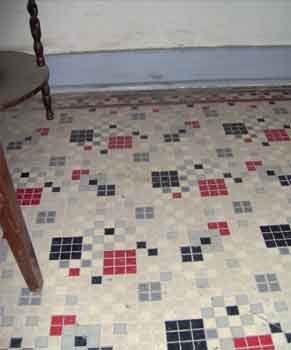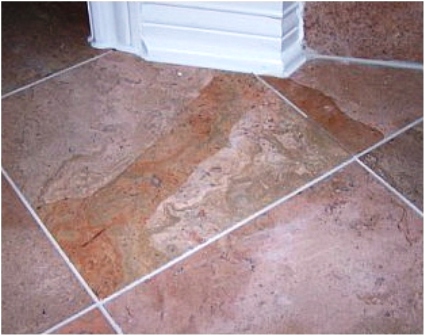Linoleum Inspection

- Wood flour, a finely pulverized wood, is used as a filler and body component, as well as to bond pigments and ensure a smooth flooring surface. Cork flour may be mixed in.
- Linseed oil is a clear to yellowish oil obtained by pressing flax seeds. When the oil is oxidized, a cement results that forms the basis of linoleum. In fact, Englishman Frederick Walton called his creation “linoleum” in the mid-1800s after the Latin words linum (flax) and oleum (oil). Linoleum’s anti-microbial qualities can be credited to linseed oil, which naturally repels germs and pests.
- Limestone and other mineral fillers are used to achieve a specific density in the linoleum flooring.
- Jute is a long, soft fiber used for linoleum backing, providing strength and dimensional stability. Grown in India and Bangladesh, jute is the world’s most produced vegetable fiber after cotton.
- Pine rosin is used as a bonding agent to provide strength and flexibility.
- Natural pigments are used to create the complex color patterns for which vintage linoleum is best-known.
Between the time of its invention in 1860 and its replacement by other floor coverings in the 1950s, linoleum was considered to be an inexpensive, durable and flexible material for high-use areas, especially kitchen floors and hallways.
Linoleum to Vinyl, and Back Again
Linoleum’s use as an inexpensive floor covering material in homes and businesses was replaced in the 1950s by polyvinyl chloride, known as vinyl. Recently, however, linoleum’s ecological, non-allergenic and anti-microbial qualities have allowed it to make a comeback. Commonly found under i ts trademark name Marmoleum® and manufactured by Forbo Flooring, linoleum is commonly installed in green homes and germ-sensitive environments, such as hospitals and other healthcare facilities.
ts trademark name Marmoleum® and manufactured by Forbo Flooring, linoleum is commonly installed in green homes and germ-sensitive environments, such as hospitals and other healthcare facilities.
- Linoleum’s patterns and colors extend down to its jute canvas backing, while vinyl patterns are stamped over a blank vinyl sheet. If years of foot traffic have worn away the surface pattern, it is not linoleum. A small razor slice can also reveal the pattern’s depth and help in identification.
- Original flooring in buildings constructed before World War II cannot be vinyl, as linoleum dominated the residential flooring market before then and for some time afterward. Vinyl is more common in newer houses, especially those built in the early '70s and later.
- A canvas backing will be present in linoleum, but not vinyl. You may look for a canvas backing in flooring that has been damaged, or carefully peel back a corner of the flooring in an inconspicuous area.
- general wear. Due to the age of the homes in which it's installed, linoleum is commonly found in some state of deterioration. Dirt in high-traffic areas and high-heeled shoes can accelerate the wearing process. Rips and tears typically result from moving heavy furniture and appliances across it. If a refrigerator or stove needs to be moved, it can be raised off the linoleum using a layer of plywood in order to minimize damage caused by dragging;

- chemical changes. Linoleum is likely to become more brittle as the linseed oil continues to oxidize. Linoleum with a high proportion of wood flour or cork to linseed oil is more susceptible to deterioration in this manner;
- asbestos. This carcinogenic mineral fiber was added to various products to impart strength and fire resistance before it was finally banned in the U.S. in 1969, but it still lurks in products manufactured before then. It's hard to be certain whether either linoleum or vinyl flooring contains asbestos without causing damage to the floor in order to submit a sample to a lab for testing. The process itself may disturb the asbestos fibers and cause them to become airborne. In floors that are confirmed to contain asbestos, inspect for signs of wear or damage, such as tears, abrasions or water damage that may allow the release of asbestos fibers into the air. Remedial actions may include covering the linoleum with carpet or removing it, but undamaged tile may not need any correction. An InterNACHI inspector may recommend an asbestos professional who can decide the best course of action. Read more in InterNACHI’s article on asbestos;

- off-gassing. Newly laid linoleum has a pronounced scent of linseed oil, and while this smell dissipates within several months, it may bother some people with allergies. However, harmful off-gassing may result from the glues used to bond the linoleum to its subfloor;
- yellowing. Also known as “seasoning bloom” and “drying-room film,” linoleum may experience a yellowing during its manufacture process due to oxidation of the linseed oil. This yellow cast is temporary and will disappear following exposure to natural or artificial light, typically between a few hours and a few weeks after installation. In areas that are hidden from light, such as the floor surface beneath area rugs or furniture, yellowing may remain long after it has left the rest of the floor;
- staining. Linoleum may be stained by rubber- or latex-backed mats due to the presence of an antioxidant. Manufacturers recommend the use of non-staining, colorfast woven rugs for use on linoleum floors;
- telegraphing. Linoleum installation requires a smooth subfloor, as any unevenness will transfer to the floor surface. Telegraphing is not as much of an issue in floating tile floors, as they are not fastened directly to the subfloor;
- failed adhesive. Bulging or peeling indicate that the adhesive used to bond the linoleum to the subfloor has failed and needs to be replaced. Sandbags can be placed over the tile aft
 er a fresh coat of glue has been applied;
er a fresh coat of glue has been applied; - moisture intrusion from the concrete subfloor. Linoleum installed over concrete may experience moisture problems. Installers can use a moisture meter to determine whether an area is too damp to install the linoleum. Signs of moisture intrusion include sponginess, unevenness, or a separation of the linoleum from the subfloor or of the jute backing from the top layer; and
- expansion and contraction of wooden subfloors. Linoleum in older homes may have buckled or cracked due to this natural process. In newer homes, installers address this problem by separating the subfloor from the linoleum by installing a layer of felt.
- Install smooth plastic glides beneath furniture legs to minimize gouging of the flooring.
- Clean spilled fluids quickly, as puddles will damage linoleum floors.
- Use a humidifier to maintain ambient relative humidity at between 50% and 60% to prevent the flooring and its components from drying out during the heating season.
- Dry maintenance, such as vacuuming and sweeping, is the safest way to keep linoleum free from dirt and grit. A damp mop can be used with a small amount of water with a neutral pH soap or a specially formulated cleaner, as long as the liquid is quickly removed. Avoid the use of chemicals that will damage the linoleum, such as bleach (which will lighten the surface color), high-alkali cleaners (which will soften the linseed oil), ammonia (which has too high a pH), and scouring powders (because they will abrade the surface of the flooring). After mopping, dry the flooring to remove excess water, as the seams of linoleum are especially susceptible to water damage. After the flooring has dried, apply a floor wax designed for linoleum floors.

